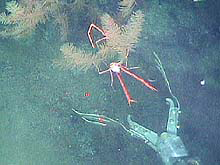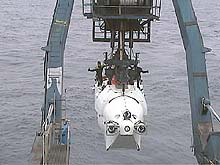
Swimmers give the “thumbs-up” during the last Alvin launch of the expedition. Click image for larger view.
Summary of the Alaska Seamount Exploration
June 22-July 15
![]()
![]() Highlights of Gulf of Alaska Seamount Exploration
Highlights of Gulf of Alaska Seamount Exploration
Biological and geological samples collected during the Alaska cruise included more than one ton of sediment and coral samples, with corals belonging to 15 to 20 different species, along with about 600 pounds of rocks and 68 crab specimens belonging to 8 different species. Full-coverage bathymetry maps were made of all seamounts visited except for Patton Seamount, where a map already existed from the 1999 Atlantis cruise, and only one of the fourteen scheduled Alvin dives was lost to weather during the 23 days at sea. The team also hosted a successful port call during the expedition. Amazingly, about 160 hours of videotape were collected during 13 Alvin dives, and a fabulous compilation of “best-of” video clips was produced.
The summaries below have been provided from the three science parties that participated in the Alaska exploration. A personal reflection is also provided from the Web Coordinator.
Highlights of Seamount Geology in the Gulf of Alaska
Highlights of Crab Research
Highlights of Deep-Sea Corals and Mapping in The Gulf of Alaska
Reflections on the Gulf of Alaska Seamount Exploration
Highlights of Seamount Geology in the Gulf of Alaska
Dr. Randall Keller
Oregon State University

A mating pair of scarlet king crabs ‘embrace' on a yellow crinoid covered boulder on Patton Seamount. Click image for larger view.
For the geologists, exploration of the Gulf of Alaska seamounts was a source of great fascination, with a little bit of frustration. The best part was getting to see the spectacular volcanic geology revealed in our SeaBeam maps and Alvin dives. The intricate and complex shapes of each seamount revealed by our nightly SeaBeam mapping tell a tale of the repeated volcanic eruptions that formed these seamounts. Despite the fact that all of the seamounts were created by the same volcanic hotspot, they are each unique in their size, shape, and volcanic features. It was even more fascinating to see the volcanic features in person through Alvin's porthole -- pillow basalts, lava conduits, and columnar jointing stood out in amazing detail on the seafloor. We were fortunate that strong ocean currents keep these seamounts free of sediment, so the original volcanic rocks are still nicely exposed.
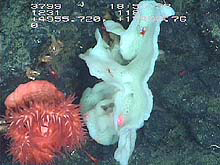
A lovely pink anemone joins a sponge on a rocky outcrop on Murray Seamount. Click image for larger view.
Our frustrations were caused by two ever-present enemies in the Gulf of Alaska: manganese crusts and ice-rafted debris. Manganese crusts are made up of hundreds or thousands of layers of manganese oxide that cover the rocks like thick coats of black paint. This makes it very difficult to tell what kind of rocks we are looking at on the seafloor without picking them up and examining them closely. Even then it can be hard to tell what kind of rock is hiding beneath the heavy coating of manganese. Our other enemy was ice-rafted debris. This is a problem in all cold regions of the oceans, and is caused by icebergs that slowly melt as they float past and drop the load of rocks they picked up when they were part of a glacier on some far-off continent. This creates a confusing mishmash of rocks scattered about the seafloor that contain no information about how our seamounts formed. It was a constant battle to try to identify ice-rafted debris on the seafloor, and to avoid these imposters by only collecting rocks that looked like they formed part of the mountainside, and then we had to work for them -- prying, wedging, and tugging with Alvin's arm -- until we liberated a rock that looked like it was part of the volcano, but was just loose enough for us to work free. Despite all this care and effort, we sometimes proudly brought back a beautiful black rock that we were convinced was part of a lava flow, only to find on close inspection aboard the ship that we had been fooled by a piece of ice-rafted debris coated with manganese. Fortunately, the few times this happened we had other samples from the same area that actually were the lovely volcanic rocks we were seeking.
As a final note, in looking out Alvin's porthole and watching the videos relationships between the geology and the biology on these seamounts. It was obvious that many of the animals preferred to live in rocky rather than muddy habitat. As we return to our laboratories to pick apart the rocks that are so important to us in our studies of how these volcanoes formed, somehow there is extra fascination in knowing that they are also crucial players in the web of life on the seafloor.
Highlights of Crab Research
Dr. Thomas C. Shirley
University of Alaska Fairbanks
One the major goals of crab research on the seamount expedition was to locate and describe the habitat of juveniles of the king crabs Lithodes aequispinus (golden king crab) and Lithodes couesi (scarlet king crab). Our preliminary observations suggest that juveniles of L. aequispinus and L. couesi were confined to a narrow bathymetric range at depths deeper than those in which the adults are normally encountered. Juveniles of L. couesi were observed from 550 to 900 m on Patton Seamount, but the juveniles of L. aequispinus occurred in a much narrower band, from 583 to 623 m depth. Almost all juvenile lithodids occurred either on exposed rock, or cobble and boulders and were rarely observed on silt or gravel bottoms. Suspension feeders, primarily yellow crinoids and brittle stars, were abundant from 583 m depth to the top of Patton Seamount (<300 m), however no juvenile L. aequispinus were observed in those depth zones, but adults of the species were common. Larval predation by the suspension feeders may prevent successful settlement by crab larvae. An alternate explanation is that adult-juvenile interactions may determine the bathymetric distribution of juveniles.
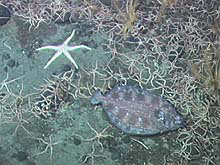
Various benthic predators on Patton Seamount. Note the white sea star, yellow crinoids, many brittle stars, and even a flatfish. Click image for larger view.
Another primary objective was learning more about the biology of the deep sea spider crabs, Macroregonia macrochira. Their biology is poorly known even though the species is common below 1000 m, and often the only brachyuran observed at the deeper depths. We captured 28 specimens either with Alvin's manipulators, or using a baited trap placed on the elevator (a platform which could rise to the surface once triggered). Ovaries of females were in varied states of development, suggesting asynchronous reproduction by the species. A significant portion of M. macrochira specimens observed in situ were missing appendages, suggesting evidence of predation or agonistic interactions. The lack of regenerating appendages among specimens implied molting of adults did not occur or was infrequent. Mating or fighting scars were present on the appendages of adult male specimens. Feeding or attempting feeding activities of many specimens was recorded on video; one large male was recorded eating an adult female, confirming cannibalism. This crab species is widespread throughout the North Pacific deep water, and may prove to be an excellent candidate for genetic research. Commensal amphipods were collected from two specimens, at depths deeper than previously recorded; the amphipods may also be candidates for genetic studies.
Decapod crustaceans are large and conspicuous members of seamount fauna. Although their species richness is low, their abundance is high within certain bathymetric zones. The crabs in particular may lend themselves to a variety of ecological studies, as after initial sampling they can be readily identified from videotapes. Many species seem to be associated with particular habitat types and the presence or absence of other fauna. Many of the smaller crustaceans (e.g., smaller crabs, shrimps, amphipods, isopods) which are difficult to collect with a manned submersible remain to be identified.
Highlights of Deep-Sea Corals and Mapping in The Gulf of Alaska
Peter Etnoyer, Staff Scientist
Marine Conservation Biology Institute
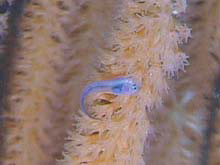
This tiny larval fish was captured on video hiding out among polyps of bamboo coral. Click image for larger view.
Deep-Sea Corals:
The results of this expedition led to the documentation of an impressive expansion of the known distribution of deep-sea coral families Paragorgia, Primnoa, and Isididae from the Pacific Rim into the central Gulf of Alaska. This suggests that other seamounts are likely to harbor deep-sea coral beds. Also documented were important functions of these deep-sea corals as habitat for galatheid crabs, amphipods, larval and adult fish. Several species of bamboo corals not previously known to the region were also collected. Exact results are forthcoming from Amy Baco Taylor (who has, at this early stage, already isolated DNA from several coral specimens) and the Smithsonian.
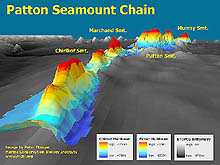
High resolution Seabeam bathymetry (in color) derived from the Atlantis shipboard echosounder is overlayed upon lower resolution ETOPO2 satellite derived bathymetry (gray tones). Click image for larger view.
Multibeam Work:
A comparison of multibeam surveys to satellite derived bathymetry revealed that satellite derived estimates of seamount peak coordinates were generally accurate within 2 km, with a range of 1 to 8 km difference in predicted peak coordinates. A comparison of multibeam surveys to satellite derived bathymetry also revealed that satellite derived estimates of seamount minimum depths were deeper than multibeam estimates by approximately 300 m, with a range between 73 m and 540 m. Patton Seamount reached within 188 m of the surface, compared to satellite derived estimates of 495 m. Warwick Seamount reached within 507 m, compared to satellite derived estimates of 581 m.
Reflections on the Gulf of Alaska Seamount Exploration
Catalina Martinez
NOAA Office of Ocean Exploration
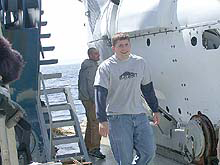
Michael Rowe, showing his exuberance after completing his first ever dive in the Alvin submersible. Click image for larger view.
Witnessing the last Alvin dive of this very exciting expedition caused me to reflect upon our three glorious weeks of exploring previously unexplored regions of our world's oceans, and I personally remain in awe of all that was accomplished in such a short time. From the extensive biological and geological samples, to the fantastic port call, to the almost 160 hours of videotape that were collected during 13 Alvin dives (and a fabulous compilation video, produced by Michael Rowe from Oregon State Univ.), the accomplishments were amazing. Through the hard work and commitment of the crew of the Atlantis, the Alvin group, and the science crew on board, the success of this expedition far exceeded all expectations.
A research cruise on the Atlantis is widely regarded in the oceanographic community as the “ultimate” at-sea experience, and I have come to appreciate that although this is very much due to the excitement of stepping into the world of manned submersibles, it is also due to the atmosphere created on board with this very special crew. It is only in the last few decades that we have developed the technology that allows us to truly explore, and to actually visit our deep ocean realms, and it was an honor to work with a group so committed to sharing the science, as well as the general “magic” of the mysterious undersea world with the general public.
On a personal note, I would like to thank all of the participants that made up the scientific complement on this cruise, as well as the crew of the Atlantis and the Alvin, for their kindness, for their generosity, and for their humor during this amazing journey, but most importantly, I would like to thank them all for their commitment to exploring the deep ocean environment and for sharing these discoveries with others.
Sign up for the Ocean Explorer E-mail Update List.





























